December 29, 2004
Wireless Politics

The Future of Digital Democracy
Wireless Politics May Determine Future of Digital Democracy, Part One of a Two-Part Series by Michelle Chen, The NewStandard, December 29, 2004.
"A teenage public housing resident searches the web for scholarship opportunities while her mother looks up tips on starting a small business. A public art space lets visitors download a multimedia exhibition onto their laptops, which are simultaneously linked to a dozen other galleries around the city. A local Independent Media Center breaks news before the major network affiliates by sending a report instantly to thousands of home computers sharing a wireless network.
You may not be able to see into the future of digital democracy, but you may already be breathing it; the new frontier, say activists and technophiles, is on the air. Broadband access and its wireless digital "ether" are giving rise to a new technological geography that defies spatial boundaries and historical precedent." Continue reading >> [via]
Posted by jo at 11:35 AM | Comments (0) | TrackBack
December 27, 2004
netzwissenschaft
![]()
Emerging Infrastructures of All (Inter)net Research
Dr. Reinhold Grether's network research | netzwissenschaft site maps the "emerging infrastructures of all (inter)net research endeavours. net.science as an anthropology of connectivity is trying to overcome the constraints of specialist method transfers on net matters. the protuberance of technical networks necessitates a professionalization of human net knowledge. neither the isolation of concepts as in basic research nor the encapsulation of processes as in applied sciences will ever be able to adequately describe the complex autopoiesis of networks. net.science is undoubtedly developing into a scienza nuova of its own right."
Check out his Mobile Art and Virtual Performance research areas.
Posted by jo at 04:45 PM | Comments (0) | TrackBack
December 22, 2004
Real Remote Guided
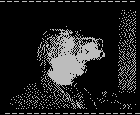
Controlled by web users
Real Remote Guided, by Antonio Lomas, features a subject who is "blinded" while the spectators / speakers on the internet and in the physical space, are able to see what the subject could see in normal circumstances.
GPS and web cam are combined with a laptop linked to the net through telecomunicaton systems (cellular telephony and/or wireless).
On the web page, the web guides see the images from the camera worn by the artist, as well as map images that define his location so that they can send him instructions, guiding him through a space of real intervention. The artist can only see the instructions sent by the users and the map images of the GPS system.
The idea is to represent, in a playful way, how new technological systems can take control. So, spectators are invited to take that control and to manage it.
Posted by Regine at 03:01 AM | Comments (0) | TrackBack
December 18, 2004
The Living Room

A narrative installation puzzle
"The Living Room", by American artist Victoria Fang, is a narrative puzzle installation. Players enter a space containing 3 rolling units with screens in them and 21 clues painted on the floor. They have to move panels with LCD monitors to solve a whodunit murder mystery. Correctly positioning the units triggers filmed scenes that play back across the three separate panels, and these scenes give the player new clues to trigger the next scene. Players get a different spatialized experience with each scene, as the scenes are constantly changing position, thus working as a giant physical puzzle that houses a narrative puzzle.
This project is designed as an entertainment experience that focuses on the cathartic release of built-up emotional tension, through the use of mobile and wireless technology.
"The Living Room" has received a nomination for Transmediale award 2005.
(PDF of the project)
Posted by Regine at 12:31 PM | Comments (0) | TrackBack
December 09, 2004
Summoned Voices
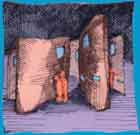
Interactionfields
Summoned Voices--by Iain Mott and Marc Raszewski--acts as a living memory of people and place. It consists of a series of door installations each with an intercom, sound system and a computer that is networked to a central file and database server. The design metaphor of the door presents a familiar scenario, that of announcing oneself at a doorway and waiting for a response from persons unknown. Signage instructs the public to speak, make sounds or sing into the intercom. Their voice is stored and interpreted, and results in local playback composed of the individual's voice with those that have gone before. Summoned Voices acts as an interpreter of sound, a message board and an imprint of a community - a place for expression, reflection and surprise.
Summoned Voices is one of the 22 projects catalogued by Mirjam Struppek for her thesis Interactionfield - Public Space in the Digital Age (2002): "The public space is a field, which is created and becomes alive through various forms of interaction.
Thus interactive art with its life proximity, communicative issues and reflection of the power of the modern technologies is well suited to be linked with the urban public space. This information platform presents detailed some selected interactive media projects, which went consciously into the urban public space. The analysis, categorization and questionaire with the producers of these 22 examples show how new media can be alternatively used, in order to contribute to the rediscovery and reactivation of the urban space and to lead to new interaction qualities. In the open expandable list further projects are collected. With the time an archive can develop, with examples, that show new ways in dealing with the public space. The links section presents various conferences, research projects, articles and specialized artists that related to this topic."
Posted by jo at 06:36 PM | Comments (0) | TrackBack
Are cell phones new media?

re-narrating cities via nomadic technologies
"Multiuser environments in cyberspace have frequently been regarded as utopian spaces in which users could project their imagination. When communities are shaped in a hybrid space, mobile phones become new media tools for creating novel and unpredictable imaginary spaces, re-narrating cities. Fixed Internet users do not have the ability to move through physical space. But the emergence of nomadic interfaces represents a chance for such imaginary spaces to be enacted and constructed in physical space.
Nomadic technologies have a twofold role in the construction of playful/narrative spaces. First, they allow virtual spaces to be mobile, bringing them into the physical world. Second, when used to play games, they free the game from the game board or the computer screen, making it possible to use the city space as the game domain." from Are cell phones new media? by Adriana de Souza e Silva [Related]
Posted by jo at 12:44 PM | Comments (0) | TrackBack
December 02, 2004
Mobile Confessional

Broadcasting Sin
The scenario of the Mobile Confessional is as follows: when you see the vehicle (called projectCAR) while stuck in traffic, you can call in to hear the message: "Welcome to the Mobile Confessional. Our service provides callers a safe and anonymous place to confess their sins to the world while commuting in Los Angeles. Your confession and an appropriate penance will be scrolled across the electronic sign in the back of the mobile confessional vehicle. Please, take a moment to share your sins with the world, so that all may forgive you."
This is only just one of the projects of Design and Technology for Mobile Experiences that tries to understand how design and technology can create compelling mobile experiences.
You are invited to attent final presentations and guest critique for the Interactive Media Division Graduate Seminar Design and Technology for Mobile Experiences, Monday December 6th from 10am-12n in the Zemeckis Media Laboratory, Los Angeles.
This modern way to make confessions reminded me of a project of Louise Wictoria Klinker and Andrea Berlinger (students at the Royal College of Art in London): the remote confession kit for catholic priests.
Originally blogged by Regine at near near future
Posted by jo at 09:01 AM | Comments (0) | TrackBack
December 01, 2004
Vena Amoris
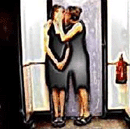
A Direct Digital Bloodflow
Vena Amoris, by Helen Paris, is a one-to-one performance which takes place on a mobile phone. (love vein/vain): Egyptians believed that the third finger of the left hand followed the vena amoris. The vein of love that ran directly to the heart. A direct, ‘digital’ blood flow. Vena amoris is a journey of narcissism and self obsession, employing both visceral and virtual means in an exploration of the perils of self desire: the danger of leaning too far over the black pond of the ever-present screen and slowly becoming captivated, immobilized in the quest for the perfect pixilated image.
"In Vena Amoris...I set out to renegotiate the boundaries of audience/performer relationships, in order to create a performance where I, as performer, would neither look nor be looked at. A one-to-one interaction was designed - not through face-to-face communication, but rather relayed via a cell phone. This decision suggested a theatrical architecture through which I could explore the degree of contact possible between audience and performer. It was accentuated by my desire to confront what and how we communicate with one another, particularly in the light of increasing digital technologies. Over the course of the installation/performance, audience members would be invited to join me, one at a time, in a series of explorations of narcissism, isolation, and immobilization, in which the direct contact and communication between performer and audience was central, and in which lone journeys converged." from Crossing Wires/Shifting Boundaries.
Posted by jo at 10:18 AM | Comments (0) | TrackBack
November 10, 2004
cyberPRINT
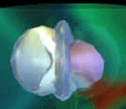
Bodies: Inside Out
cyberPRINT is a virtual reality dance environment...(W)hile a dancer performs on stage, he or she is wearing wireless sensors that monitor key physiological signs (respiratory and muscle activity, cardiac activity and the nervous system). Then, these measurements are captured in real-time during a performance and projected via colorful 3D renderings on a screen for the audience to watch...You can read the main write-up about the cyberPRINT project, which includes a good overview, descriptions of the technologies and images.
Multimedia choreographer and artist Yacov Sharir, the creator of the cyberPRINT project, conducted a workshop about this program at this September's Symposium on Arts & Technology. Here's how this workshop is described:
"The cyberPRINT is a real time Virtual Reality (VR) environment that totally surrounds a dancer during performance. This electronic architectural and musical bio-feedback system is driven by physiologic data drawn from the performer via special sensors attached to her body and transmitted wirelessly to computers which, in turn, generate and project a especially designed and programmed 3D/music world in real time. The resulting "architecture of being" offers multiple expressive choices as its multidimensional character undergoes continuous change. Although the use of the body to electronically drive media events is not new, most of the existing works have paid little or no attention to the potential of interactive 3D and aural virtual environments. Nor have they been so technologically advanced, interdisciplinary involved, or spatially focused as the cyberPRINT. The cyberPRINT has been nationally and internationally performed with success since May 2000." [via]
Posted by jo at 10:37 AM | Comments (0) | TrackBack
November 06, 2004
The Book of Rage and Longing
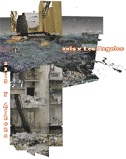
Raging by the Book
In ancient Greek comedy, parabasis named 'a part sung by the chorus, addressed to the audience in the poet's name, and unconnected with the action of the drama.' Calling themselves 'the bodies of rage and longing,' six artists and filmmakers based in the United States - Dimitri Kotsaras, Mr. Flo, Melissa Longenecker, Jennifer Nelson, Michael Wilson, and Natalie Zimmerman - have devised an ongoing, collaborative project to promote parabasis transnationally. With foci in Los Angeles and Athens, The Book of Rage and Longing stages an interrogative return to the putative birthplace of Western democracy. Viewers submit textual or visual rants, connected or unconnected with the daily unfolding dramas of wars worldwide. Unedited, these texts and images are projected on a rooftop facing the Acropolis. An 'interpretive/administrative committee' modifies these contributions, reshaping them into the titular book, segments of which a group of Greek singers then performs. Rea! d in the aftermath of this year's presidential election, these instances of parabasis have begun to seem rather more tragic than comic, as when one self-styled poet opines, 'From those who live like leeches on the people's lives,/ We must take back our land again,/ America.' - Ramsey McGlazer, Rhizome's Net Art News, November 5, 2004
Posted by jo at 10:25 AM | Comments (0) | TrackBack
October 28, 2004
MapTribe
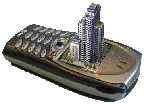
A tool for collaborative mobile learning
MapTribe is a software application for mobile phones. It enables group of users to see each other's position on a city map on the screen display, and to add on this shared map a certain number of objects that will positioned on the map according to the user's real position in the city.
MapTribe is based on the idea that every person retains and develops over time an image of the spaces s/he lives, which may be quite different from the physical inhabited place. It is commonly experienced, in fact, that places are enriched of psychological features that transform their perception. MapTribe is a tool for exchanging and comparing these personal images of the city among a group of friends. The tool we are developing helps people in analysing, capturing and visualizing this mental structure and to share it in a social network. From the negotiation of the differences between the maps of each participant in the group, a common understanding raises, an informal learning obtained by each user of the system about the image of the city.
Posted by jo at 10:37 AM | Comments (0) | TrackBack
Cell Phone Drum Machine

Collaborative Rhythm Generator with an SMS Interface
Cell Phone Drum Machine is a rhythm generator that can be controlled by users with their phones by sending text messages. Here's how it works: the operator links his/her phone to the computer and starts the drum sequencer. Users can then send special SMS commands to the operator's phone that controls the rhythm. The on-screen display shows from which phones commands originated.
Matt Hall and John Watkinson will present the project at dorkbot-nyc on Wednesday, November 3rd, 7pm at Location One in SoHo.
Posted by jo at 10:08 AM | Comments (0) | TrackBack
October 20, 2004
Public Displays of Affection
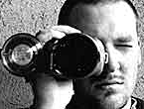
Affect and its Exhibition in Public
Public Displays of Affection
An Interdisciplinary Graduate Student Conference
Visual and Cultural Studies Program
University of Rochester
Friday, April 8 & Saturday, April 9, 2005
CALL FOR PROPOSALS
Civility can be viewed as a series of performances that generate a range of emotions, including the patriotism of war, the joys of shopping, and the fear of urban crime. The public display of affection constitutes a contest of meaning in which various appeals are made to organize the emotional life of the individual and the rules of decorum. To be convinced of this idea one only has to turn on the television. From the not-so carefully scripted emotions of the recent Presidential debates, to the ongoing pageantry of heteronormative romance, to the proscribed images of mourning for war casualties, it appears that the politics of putting your heart into the public sphere are by no means certain, but certainly meaningful.
PUBLIC DISPLAYS OF AFFECTION aims to explore the value of affect and its exhibition in public. Disturbed by formations of the public sphere as a wholly rational space for the exchange of collective ideas and actions, we turn instead towards the multiple meanings or uses of public feelings. We are interested in the specificity or uniqueness of emotions and how they shape historical moments and geographic sites.
We invite proposals from across disciplines, research interests and theoretical persuasions that engage with P.D.A. through specific forms of display: museums, galleries, mass media, film, theatres, festivals, etc. Possible areas of inquiry might include, but are not limited to:
Nationalism and/or spectacular nations
Political protest
Public/private space
Public sex
Marriage
Family
Feminism
Queer history and theory
Empathy, sentiment, depression, rage and other kinds of affect
***DEADLINE for submissions: December 15, 2004***
Submissions for 20-minute papers should be in abstract form (250-500 words). A self-addressed stamped envelope must accompany all submissions requiring return. Please include e-mail addresses with all submissions whenever possible.
Abstracts and inquiries may be sent via e-mail to: vcsconf @ mail.rochester.edu
Printed submissions should be sent to:
Organizing Committee for "Public Displays of Affection"
c/o Program in Visual and Cultural Studies
424 Morey Hall
University of Rochester
Box 270456
Rochester, NY 14627-0456
ABOUT THE PROGRAM
The Program in Visual and Cultural Studies is an interdisciplinary graduate program at the University of Rochester. Its focus is visual culture and critical theory; the Departments and Programs of Art and Art History, English, Film Studies, Anthropology, History, and Modern Languages and Cultures, as well as the Susan B. Anthony Institute for Women and Gender Studies, constitute its academic base. Web site: http://www.rochester.edu/college/AAH/
Posted by jo at 02:39 PM | Comments (0) | TrackBack
October 15, 2004
Mapping
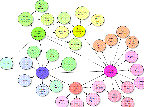
Alternative Categories
"In preparation for Wednesday's Urban Gaming lecture, we thought we'd make a map. We've mapped psychogeography, nomadic communication and technologically infused public space as enablers of the urban gaming explosion. Gaming is the perfect structure for experimenting with these new tools, places and communities. The dynamics between online and offline players, person and space, space and technology, person and technology are being stress tested and observed in the form of games in media labs, art collectives and companies throughout the world. And it's evolving to be a mechanism for social activism as well- so there you go!" From community-centric.
Posted by jo at 01:12 PM | Comments (1) | TrackBack
Love One Day

Time, Space, Love
'love one day' was a real one-off action through time and space, presented live online and later as a cinematic video installation. Two people from two distant parts of the UK started a long journey to London. They met in a hotel bedroom and within 24 hours of starting their journey, they left. 'love one day' explored the communication between two people whose anticipation of love was heightened by the unique circumstances of their journey. It documented the emotions, thoughts, observations and behaviour of two 'matched' individuals as they traveled towards each other and met one day. 'love one day' investigated psychological motivations, how we communicate and interact with others and how we are affected by our environment, space and time.
A unique 'love one day' dating website was created. This allowed people to submit their personal profile and browse/chat amongst other candidates looking for the perfect match during one month. The website took on a similar format to that used by online dating agencies with specific questions designed to recruit two protagonists for a journey to meet in London. 'love one day' was publicised and promoted through online listings, press and 'satellite venues' (public spaces and institutions supporting the project) as well as the website's established visitors and target audience.
Two people from a selection of 'matched' couples via the 'dating website', were interviewed and chosen to become the main protagonists of this experience. People prepared to accept the role of protagonist by embarking on an emotional and physical journey to meet someone they have never met in a hotel bedroom were sought. They were chosen on the basis that they made a good love match.
The two selected protagonists were each given a mobile phone to continue their communication by phone, in text and images so they could get to know one each other a little more before their journey started. No direct contact was allowed until they met for the first time in the hotel during filming. The entire journey was filmed and the telecommunications were documented live on the love one day website. The protagonists later met with a relationship psychologist to feedback about their experience.
'love one day' is a project of completely naked.
Posted by jo at 01:01 AM | Comments (0) | TrackBack
October 11, 2004
Platfrom

Routed Narratives
Platfrom, by Rachel Baker, uses the platform of the mobile phone within a very specific context the train journey. A series of playful SMS messaging scenarios will make a relation between mobile phone and rail network as communication systems. Focusing on privatised, proprietary networks the railway and the mobile phone the project will invert them into opportunities for public and group interaction. It offers moments for train culture and SMS culture to integrate, taking advantage of a journey's incidental nature (delays etc.) with unknown consequences by creating a common gateway between train traveller and static web user and including them both in a narrative along a particular route. The narrative at this stage is dictated by the route from South to North and the contiguous cities and landscape. Read more [PDF]. Also read an essay by Matt Locke.
Posted by jo at 11:52 AM | Comments (0) | TrackBack
October 05, 2004
Life: a User's Manual, Part 2

Inhabiting Image Spaces
Commissioned by and currently on exhibit at Impakt Online, Life: a User's Manual locates the city of Utrecht as its game board, where every story, every piece stands on its own, but is part of an intricate jigsaw puzzle. Both public physical spaces and private interior spaces contain traces of fragmentary personal [hi]stories tied together by an invisible network of media. How people inhabit the hidden 'image spaces', discovered by a wireless surveillance camera scanner, while at the same time inhabiting physical outdoor spaces, was revealed through the daily practice of walking during the Impakt Festival 2003. The findings of Michelle Teran's walks have been arranged on a map of Utrecht's secret transmissions.
Life a User's Manual is a series of walking performances taking place in different cities (see an earlier post on this site), based around the activity of tapping into the unencrypted transmissions of wireless security cameras using a 2.4 Ghz receiver. In a search for the hidden stories within the city, a walk through the urban streets reveals an invisible network of watched spaces. The unencrypted signal from the camera leaks into public space, making it easily viewable from the street. This puts us in an interesting moment of uncertain inhabitation, of being in two spaces at once.
A tiny fraction of the spectrum of the airwaves has been allocated for public use, as if space and the air are not public already. Taking advantage of this unlicensed part of the spectrum, we have seen an increased used of wireless devices that are all fighting for use of this narrow band. Use of wireless [wifi] networks, cordless phones, bluetooth, and wireless cameras transmitting on this frequency contributes to an already existing invisible world of electromagnetic fields and frequencies that saturate our bodies on a daily basis. It becomes impossible to separate our bodies from the traffic reports, surveillance video, phone calls and pop songs of others. We wear each other's information.
Posted by jo at 11:10 AM | Comments (0) | TrackBack
September 29, 2004
The Invisible Train
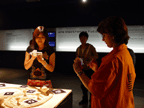
The Invisible Train is a mobile, collaborative multi-user Augmented Reality (AR) game, in which players control virtual trains on a real wooden miniature railroad track. These virtual trains are only visible to players through their PDA's video see-through display as they don't exist in the physical world. This type of user interface is commonly called the "magic lens metaphor".
Players can interact with the game environment by operating track switches and adjusting the speed of their virtual trains. The current state of the game is synchronized between all participants via wireless networking. The common goal of the game is to prevent the virtual trains from colliding. Watch the Quicktime video. Invisible Train will be demonstrated at the International Symposium on Mixed and Augmented Reality (ISMAR 2004) in Arlington, VA.
Originally from waxy. Reblogged by tripp USC Interactive Media Division blog, and by emily on near near future.
Posted by jo at 12:59 PM | Comments (0) | TrackBack
September 28, 2004
oh that ether!

More on Sky Ear
Rereading David Pescovitz’s article State of the Artists, where he discusses Sky Ear–a “surreal electric ‘cloud’ of mobile phones and helium balloons that connect participants with the electromagnetic ether…," I am reminded of early radio.
It was Guglielmo Marconi who first exploited Heinrich Herz’s discovery of electromagnetic radiation and demonstrated that radio waves could be used to transmit morse code over hundreds and then thousands of miles. When he first introduced wireless to America, during the popular America Cup races in 1899, the press hailed him as a hero and a wizard. Wireless itself evoked “psychic metaphors” (see Susan Douglas’ great book, Listening In). It was magic; Popular Science Monthly wrote that it was as if “the nerves of the whole world (were)…being bound together.” And the reputable scientist, Sir Oliver Lodge, one of the leaders of the British Association for the Advancement of Science, suddenly began praising mediums, insisting the dead don’t die and describing contact with the spiritual world. The connection between radio, the ether and spirituality ran strong.
Sky Ear, which is designed to acquaint you with these same "hidden mysteries of the wireless spectrum” by triggering high-intensity colored LEDs within the cloud, seems to be falling on a different sensitivity in 2004, with one correspondent remarking that “putting mobile phones into the clouds just to blink colors is ridiculous.”
Sky Ear had its last public launch in England on September 15, and according to its web site, there are no confirmed "flights" planned for the future, although talks go on. For more on Sky Ear and other works by Usman Haque. For more on radio: Susan J. Douglas, Listening In: Radio and the American Imagination, Times Books, 1999.
Posted by newradio at 04:19 PM | Comments (0) | TrackBack
September 26, 2004
QUIXOTE

A Moblog Performance in Turin
During the week of September 23, 2004 Quixote, a puppet, will explore Turin travelling within a network of writers, undefined at the beginning and growing day by day. Their task will be to accompany him around sharing his story with us, chronicling his journey through the city.
Quixote's journey is tracked via a GPS/GSM system in order to show on the website the exact geo-location of each moblog post and to define the topology of the network arisen during the performance. The project is an ongoing investigation around digital mobility and social networks in relation to new forms of mobile expression and interaction.
Posted by jo at 03:45 PM | Comments (0) | TrackBack
physical proximity
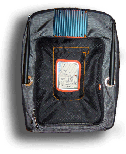
WiFi.Bedouin
Conceived and developed by Julian Bleecker, WiFi.Bedouin is a wearable, mobile 802.11b node disconnected from the global Internet. It forms a WiFi "island Internet" challenging conventional assumptions about WiFi and suggesting new architectures for digital networks that are based on physical proximity rather than solely connectivity. Most significantly, WiFi.Bedouin facilitates the creation of a truly mobile web community.
WiFi.Bedouin is designed to be functional as well as provocative, expanding the possible meaning and metaphors about access, proximity, wireless and WiFi. This access point is not the web without wires. Instead, it is its own web, an apparatus that forces one to reconsider and question notions of virtuality, materiality, displacement, proximity and community. WiFi.Bedouin is meant to suggest that what are often considered two entirely separate realms - virtual and physical worlds - are actually a much more entangled hybrid space. (from the web site)
Posted by newradio at 02:06 PM | Comments (0) | TrackBack
September 25, 2004
Leaders or Followers?
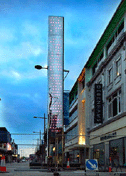
State of the Artists
"Do we drive technology or have we become just passengers? How do we navigate a reality where the lines between the virtual and real are blurred? What is our relationship to our environments, and each other, in an increasingly mediated world?
These questions have been at the heart of electronic art since its birth in the 1960s. It was then that Bell Laboratories Telephone engineer Billy Kluver collaborated with future-minded artists like John Cage and Jean Tinguely on groundbreaking works incorporating, and often critiquing, technology's state-of-the-art. Of course, that tradition continued through the dawn of the digital age and the emergence of the Web. And now it's rising in the vast spectrum of wireless telecommunications." Continue reading David Pescovitz's article at TheFeature.
Posted by jo at 12:06 PM | Comments (0) | TrackBack
September 21, 2004
Life: A User's Manual
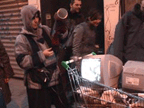
Subverting Surveillance Tactics
Life: A User's Manual is a public performance by media artist Michelle Teran where she dresses up like a bag lady and carries an antenna made out of a soup can while pushing a shopping cart full of televisions along a designated route in Brussels, Belgium. The antenna is connected to a 2.4 GHZ X-10 video scanner which picks up signals from wireless cameras deployed by stores, homes, or police in the buildings and neighborhoods she passes. The found signal is the displayed on the TV in her cart. This type of surveillance is a theme of Teran's work that attempts to make hidden or private CCTV streams into public performance and online mappings. Really interesting take on the act of subverting existing surveillance tactics by displacing the context of the medium.
From her description: “The city is a game board, where every story, every piece stands on its own, but is part of an intricate jigsaw puzzle. Both public physical spaces and private interior spaces contain traces of fragmentary personal [hi]stories tied together by an invisible network of media. How people inhabit the hidden ‘image spaces’, discovered by a wireless surveillance camera scanner, while at the same time inhabiting physical outdoor spaces, is revealed through the practice of walking.” From jonah at coin operated.
Posted by jo at 07:39 AM | Comments (1) | TrackBack
September 20, 2004
Tactical Sound Garden [ TSG ] Toolkit

Shaping Space Through Sound
The TSG Toolkit is an open source platform for cultivating public "sound gardens" within urban environments. The TSG offers the urban dweller a participatory role in shaping the soundscape of contemporary public space: it enables anyone with a WiFi enabled mobile device (handheld, laptop, etc) to "plant" sounds within a networked, 3D audio environment. These "plantings" are mapped onto the coordinates of a physical location, overlaying a collaboratively constructed soundscape onto a specific urban space. Wearing headphones connected to a WiFi enabled device, participants drift though virtual sound gardens planted by others as they move through the city.
Posted by jo at 12:37 PM | Comments (0) | TrackBack
September 15, 2004
Elastic Test
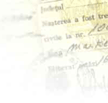
eliminate undesirable foreigners
Immigration authorities around the world need our help!! Use this website to contribute your ideas or proposals for an elastic test that can be devised to eliminate undesirable foreigners.
Immigration Statutes around the world are generally written using vague or abstract notions such as good moral character. It is the messy job of the courts to make such abstractions concrete, to objectively test and measure the moral character of a foreigner, and to eliminate arbitrary or contingent factors from the immigrations process. Join us in doing our part. We will invent, develop and implement numerous elastic tests, which can help the authorities contain and eliminate undesirable foreign bodies. Some of these tests will then be executed on our foreign test subject in a series of live and webcast performances.
Robert Lawrence (UNIMAS, Sarawak, Malaysia and USF, Tampa, Florida) wrote to us about this project on July 22, 2004. He said:
This project from the beginning has had an open door for participation through the web, but currently we are looking for ways to decentralize the project in more significant ways. Some issues related to this on which we are cogitating:
1. Given that our interventions require location-specific collaborations, how can the role of trans-local media, networks or distribution channels be re-imagined?
2. How can the project become less centralized? What are some models of de-centered cooperation we can try to implement – what is the advantage of a distributed network of creators in this case?
3. How might considerations of distribution and re-usability expand the current scope of the work?
4. One of the important aspects of the work is initiating and facilitating new relationships between local communities and structures – is this sustainable?
As we continue to evolve this project and develop ways to ‘turn it loose’ we are very interested in engaging in dialogue, theoretical and practical collaborations, and discovering and developing new models for distance collaboration.
Another of Lawrence's projects Un Message, Evidemment was blogged here.
Lawrence had this to say about it:
"The ‘story’ will be told entirely in the recorded messages that the foreground characters are listening to on their cell phones. These stories will be selected, synthesized and/or adapted from the contributions at this website and other venues. These stories will be gathered in several ways. Whenever the film in progress is shown at festivals, workshops or any other venue people will be asked to contribute storys by phone, sms, email. Participants will be encouraged to engage the performance on any number of levels.
We are also seeking opportunities to workshop the film doing shooting or writing. The “completed” film provides another dimension of the viewer/performer dynamic. At every stage of production, post-production, and presentation the ‘final form’ of the film will be negotiable. It will be shown in a user interactive form on the web, and in ‘concrete,’ though varying, versions in festivals and the usual film art venues – It may not ever appear in the same form twice."
Posted by jo at 08:46 AM | Comments (0)
September 12, 2004
mobile performance group
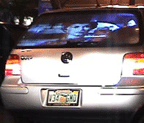
(auto)mobile performances
04.15.04 Downtown Orlando FL: Using the automobile as a mobile performance apparatus MPG presented a live performance which included real-time video and audio processing techniques. This project used two cars, one with audio performers the other with video performers. Using wireless networking and a FM transmitter the two cars where able to keep in sync and perform together as they moved through the city. Performers where Laura Oxendine, Adam Roberts, Martha Garzon, Damion Waters, Bryan O'neal, Ben Hustis, Julius Santiago, James Auten, Chester Udell, Jamie Tauler. Project Leaders where Nathan Wolek, Matt Roberts.
MPG:Mobile Performance Group is a collective of new media artists interested in finding new ways to present art outside of traditional venues. The Group was founded by Matt Roberts and is based in Florida. Using custom video and audio software instruments in real-time, and original video and audio recordings, Roberts and Wolek will present a meditation on the Florida Landscape which will be realized as an improvised new media performance at the New Forms Festival, Vancouver, Canada on October 24, 2004.
Posted by jo at 04:46 PM | Comments (0)
September 08, 2004
CitiTag

mediating social experience
CitiTag is a wireless location-based multiplayer game, designed to enhance spontaneous social interaction and novel experiences in city environments by integrating virtual presence with physical. In the first version of CitiTag you roam the city with a GPS- and WiFi-enabled iPaq PocketPC in search for players of the opposite team that you can ‘tag’. You can also get tagged yourself if one of them gets close to you. Then you need to find a friend to free you. Urban space becomes a playground and everyone is a suspect.
Posted by jo at 11:03 AM | Comments (0)
September 05, 2004
Work by Usman Haque
Usman Haque designs interactive architecture systems and researches how people relate to each other and their spaces. "The domain of architecture has been transformed by developments in interaction research, wearable computing, mobile connectivity, people-centered design, contextual awareness, RFID systems and ubiquitous computing. These technologies alter our understanding of space and change the way we relate to each other. We no longer think of architecture as static and immutable; instead we see it as dynamic, responsive and conversant. Our projects explore some of this territory." Performative works include:
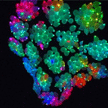 Sky Ear, 2004: This non-rigid "cloud", made up of several hundred glowing helium balloons will be embedded with mobile phones. As visitors to the event call into the cloud to listen to the distant electromagnetic sounds of the sky (including whistlers and spherics), their mobile phone calls will change the local hertzian topography; these disturbances in the electromagnetic fields inside the cloud will alter the glow intensity of that part of the balloon cloud. Quicktime video: 19 MB
Sky Ear, 2004: This non-rigid "cloud", made up of several hundred glowing helium balloons will be embedded with mobile phones. As visitors to the event call into the cloud to listen to the distant electromagnetic sounds of the sky (including whistlers and spherics), their mobile phone calls will change the local hertzian topography; these disturbances in the electromagnetic fields inside the cloud will alter the glow intensity of that part of the balloon cloud. Quicktime video: 19 MB
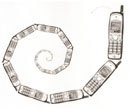 Japanese Whispers, Tokyo (2000): Similar to the children's game known as "Chinese Whispers" or "The Telephone Game," this project looks at how a message is changed by being passed from one mechanism to another--in this case the cellphone.
Japanese Whispers, Tokyo (2000): Similar to the children's game known as "Chinese Whispers" or "The Telephone Game," this project looks at how a message is changed by being passed from one mechanism to another--in this case the cellphone.
Cellphones are laid in a circle and calls are initiated from one phone to another in a variety of patterns with differing results. The sound degrades at each step as it is transformed from analog to digital and back again, emphasising the circular nature of communication. The iterative process of the feedback loop amplifies miscommunications inherent in the transmitting of information. Quicktime video: 9.2 MB
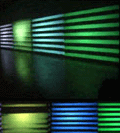 Infinitum Ad Nauseam, Tokyo (2000): The project is a video/audio performance installation which requires the explicit participation of the audience. Essentially, the system uses video and audio feedback to create sounds (from images and movements) and images (from sounds and movements). 4 video cameras, 4 video projectors, 2 video mixers and an audio mixer are used to initiate a massive feedback loop of video-video, video-audio, audio-video and audio to audio. This creates dynamic real-time images and sounds in "conversation" with the visitors or performers. There are no pre-recorded images and no computerised images used in the installation. Videos>>
Infinitum Ad Nauseam, Tokyo (2000): The project is a video/audio performance installation which requires the explicit participation of the audience. Essentially, the system uses video and audio feedback to create sounds (from images and movements) and images (from sounds and movements). 4 video cameras, 4 video projectors, 2 video mixers and an audio mixer are used to initiate a massive feedback loop of video-video, video-audio, audio-video and audio to audio. This creates dynamic real-time images and sounds in "conversation" with the visitors or performers. There are no pre-recorded images and no computerised images used in the installation. Videos>>
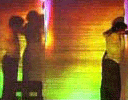 Changing Faces of Gesture, Tokyo (2000) with Charlotte Boye-Christensen (Choreographer/Dancer): The performance consists of one person and 2 to 4 large video projections. Using a simple video feedback system (where a video camera is pointed towards the screen upon which its image is being projected) coupled with an audio feedback system, complex images are created in realtime which are manipulated by the performer's movements. Images created resemble reflections in a puddle; these can be coloured using filters on both the cameras and the video-projectors. Furthermore each projector can be separately controlled to multiply the effects and simulate everything from a solitary dancing figure to a bustling crowd of people. Videos>>
Changing Faces of Gesture, Tokyo (2000) with Charlotte Boye-Christensen (Choreographer/Dancer): The performance consists of one person and 2 to 4 large video projections. Using a simple video feedback system (where a video camera is pointed towards the screen upon which its image is being projected) coupled with an audio feedback system, complex images are created in realtime which are manipulated by the performer's movements. Images created resemble reflections in a puddle; these can be coloured using filters on both the cameras and the video-projectors. Furthermore each projector can be separately controlled to multiply the effects and simulate everything from a solitary dancing figure to a bustling crowd of people. Videos>>
Posted by jo at 11:42 AM | Comments (2)
August 31, 2004
imaginary and symbolic meetings
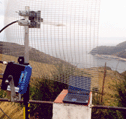
Walter Benjamin >< Marcel Duchamp
From Franck Ancel: "During a trip to Barcelona in 1997, a railway workers’ strike blocked off the French-Spanish border to me. This chance situation enabled me to explore two border villages at the feet of the Eastern Pyrenees. Two significant structures caught my attention: the Walter Benjamin memorial in Port Bou on the Spanish side called Passage by Dani Karavan, and, on the French side, the Hôtel Belvédère du Rayon Vert built by Léon Baille, the Perpignan architect.
On one side there is this memorial to Walter Benjamin who committed suicide on 26 September 1940, and on the other a building in the boat style of the 1930s containing a former cinema and theatre, listed as a 20th-century heritage building, whose name, for me, is immediately synonymous with Marcel Duchamp.
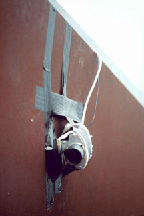 I would have to wait until the electronic projection of 23 November 2002 at the convent of La Tourette (built by Le Corbusier and Xenakis) to be able to question artistic and aesthetic boundaries in a more direct manner, in order to find out the necessary information for a search that has enabled me to talk today about these two locations in Catalogne.
I would have to wait until the electronic projection of 23 November 2002 at the convent of La Tourette (built by Le Corbusier and Xenakis) to be able to question artistic and aesthetic boundaries in a more direct manner, in order to find out the necessary information for a search that has enabled me to talk today about these two locations in Catalogne.
Benjamin’s thought and Duchamp’s art are scheduled to be brought into play during the weekend of 27 September 2003 at this Franco-Spanish border location, and this is seen as an imaginary and symbolic meeting. It is a result of, and follows, the mark that these two great figures have left behind them which has totally transformed artistic and aesthetic boundaries in the 20th century.
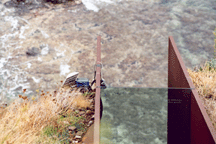
This production will cross physical boundaries and will link the two locations of Port Bou and Cerbère. In other words, the Walter Benjamin memorial in Spain and the Hôtel du Rayon vert in France. The event will attempt to mark the boundaries of the art disciplines and will be mainly held in the Hôtel’s theatre auditorium where our audiovisual reception will be held.
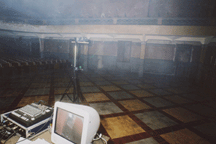
These days, it is almost considered to be an essential requirement that this comparison will use new technologies. It will therefore be through the use of wifi wireless network, together with interactive software, that we will travel beyond the physical boundary.
Our journey through and between these two locations reconnects a whole set of different information:
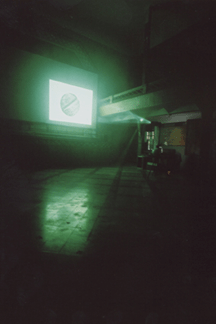
- The fictional novel Traité d’abrégé de littérature portative (Abridged Treatise on Portable Literature) by Enrique Vila Mata and published in 1985, and which depicts Duchamp and Benjamin in Port Bou as part of a secret society linked to the number 27,
- The Rayon Vert laser created by Dani Karavan for the Electra exhibition in 1983 which linked the Musée d’Art Moderne (Modern Art Museum) of Paris, the Eiffel Tower, and the Assur Tower located in the Défense quarter,
- The photograph entitled Rayon Vert by Denise Bellon for Duchamp, which was given to the set designer Frederick Kiesler, for the superstition room at the surrealist exhibition, held in Paris in 1947, the same year that Music for Duchamp was composed by John Cage.
Convergence points of the universe that have hitherto been parallel, and overlooked links, will appear at this event. This fake dimension will, however, can give another meaning to a trip, appropriate to our world, which is henceforth informational and chaotic.
This gathering consequently offers you a short-lived journey across a virtual world of concepts. It will extend the enquiry into the notion of the decline of the “aura” in the wake of computing technology, and serves as homage to Walter Benjamin."
Contact Franck at franck.ancel at wanadoo.fr
Posted by jo at 11:13 AM | Comments (0)
August 30, 2004
Christophe Bruno
FashMobs and WiFi-SM
I came across this post on boing boing today: it suggests the possible fascist undertones of flash mobs, "depending of course on who organizes the particular gathering, their motivation..." It then refers to Christophe Bruno who has created a net art work called Global Artists. Bruno asks "Imagine that the history of the world was turned upside-down and that the historical characters who left their mark in our schoolbooks, were reincarnated as... artists. What works of art would they produce?" One example he gives is FashMobs by A.Hitler:
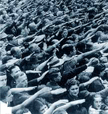 "I created a website where people can leave their mobile phone number. The idea is that when the number of people is large enough, a SMS instruction is sent to all of them simultaneously by the server. When they receive it, people have to perform the instructions. The instructions are simple ones, like raising an arm, but the effect is amplified by the fact that many people do it in the same place, at the same time, as in a symphonic orchestra."
"I created a website where people can leave their mobile phone number. The idea is that when the number of people is large enough, a SMS instruction is sent to all of them simultaneously by the server. When they receive it, people have to perform the instructions. The instructions are simple ones, like raising an arm, but the effect is amplified by the fact that many people do it in the same place, at the same time, as in a symphonic orchestra."
Similarly disturbing is WiFi-SM: Feel the Spectacle of Pain. 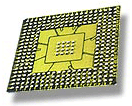 "You have the impression that the disasters of the world do not touch you anymore? You feel vaguely sorry for other people's misfortunes but you don't feel the inner urge which used to make you help your neighbour? WiFi-SM is the solution!"
"You have the impression that the disasters of the world do not touch you anymore? You feel vaguely sorry for other people's misfortunes but you don't feel the inner urge which used to make you help your neighbour? WiFi-SM is the solution!"
Bruno reminds us that, as always, technologies can be abused and/or produce the opposite effects for which they were orginally intended. Or, is this what they were orginally intended to do?
Posted by jo at 10:59 AM | Comments (1)
August 28, 2004
Bikes Against Bush

Breaking News! Josh Kinberg Arrested!
Josh Kinberg (see our Bikes Against Bush post) was arrested [watch video] while being interviewed about his Road Writer bicycle. This news comes after I personally road in Critical Mass last night and a person in our riding group was arrested. HERE IS THE EMAIL about Josh word for word:
"...about 40 minutes ago Josh was doing an interview with Ron Reagan and in the middle of it the police pulled up. 20 minutes later a captain came down to the scene (all still while on camera with Ron reagan) and after some time arrested Josh. they took the bike too. Josh is OK. We were all shocked that it would happened like that. a crowd had formed and many journalist wondered into it. Josh was little shocked but, it was all peaceful and calm just very very frustrating and absurd. - YURY GITMAN"
From | alison | juliaset, 08.28.2004: 13.19.35
Read an article.
"Joshua was released from police custody at 11:00 AM on Sunday. Lawyers from the National Lawyer Guild believe that the case is a clear violation of the first amendment and should be thrown out. Joshua's bicycle, laptop, and cell phone have all been confiscated, however, and are being held until his court hearing. The court date has been set for Friday, 9/3, after the end of the RNC. An alternative link to the video can be found at http://dv.open4all.info/?postid=70"
posted by: yatta on juliaset
Read Josh's account of what happened.
Posted by jo at 01:25 PM | Comments (0)
ubiquitous computing and the production of space

Call for WiFi.ArtCache Participants
This is a call for contributions to art-technologists interested in contributing to the WiFi.ArtCache during its exhibition at Spectropolis October 1-4, 2004. Deadline for submissions is September 26th.
By simply coding to a provided ActionScript 2.0 API, Flash artists are able to create an interactive experience that changes based on how many people have downloaded their art object, how many people are currently interacting with their art object, or whether their art object is currently in range of the WiFi.ArtCache. Here are earlier posts about WiFi.ArtCache and Spectropolis.
The WiFi.ArtCache is a physical object server containing a standard WiFi 802.11 access point. When exhibited at the Spectropolis event at New York's City Hall Park in Lower Manhattan, the WiFi.ArtCache will contain a storehouse of art objects. Visitors to the event can download these art objects onto their 802.11 equipped laptops and experience the artists' interpretation of location and proximity effects.
Developer documentation and downloads can be found at:
http://wifiartcache.techkwondo.com/overview.jsp
http://artcache.techkwondo.com/overview.jsp
Please send submissions, questions and inquiries to wifiartcache at
techkwondo dot com.
General information about the WiFi.ArtCache concept can be found at:
http://www.techkwondo.com/projects/artcache/
Additionally, the WiFi.ArtCache will contain a generic storehouse of digital ephemera that visitors can upload and download to the server. Scratchy audio, yellowed digital documents, discolored image files and spoiled emails can all be found and dropped off at the WiFi.ArtCache.
WiFi.ArtCache was developed by Julian Bleecker with support from Eyebeam Atelier. This exhibition is sponsored by the Downtown Alliance, NYCWireless, the Lower Manhattan Cultural Council and Spectropolis. Spectropolis is curated by Wayne Ashley, Yury Gitman and Brooke Singer
http://spectropolis.info
http://www.techkwondo.com/projects/artcache
http://www.eyebeam.org
http://www.nycwireless.org
http://www.lmcc.net
Posted by jo at 10:57 AM | Comments (0)
August 26, 2004
PING

Presence and Absence
PING, by Kate Armstrong, uses a telephone menu system to distribute active commands to participants who call in using cellular telephones. The choices made by the caller when navigating the telephone system produce directions for physical movement through the city.
PING comes out of psychogeographical inquiry, which focuses on the study of the effects of the environment on the perception, behaviour and mood of individuals. PING is intended to explore the interface between disparate fields such as situationist thought that focuses on subjective mood, generative psychogeography which introduces algorithms as a way to inspire movement through urban space, existentialism, and the interpolation of digital metaphors onto physical, analog space. Read "A Psychogeographical Account of PING and the PsyGeoConflux 2003" by Kate Armstrong.
Posted by jo at 11:08 AM | Comments (0)
August 25, 2004
Poetrica

Teleintervention
Poetrica is an investigation about reading and reception in cybrid and entropy situations. The project involves a series of visual poems conceived by Giselle Beiguelman with non-phonetic fonts (dings and system fonts), a DVD, digital prints, movie trailers and a teleintervention which allowed to anyone compose visual messages and submit them, by the Web or SMS, to three commercial electronic billboards located in downtown São Paulo, using the same typographic background she used in her nomadic poems.
Posted by jo at 07:51 PM | Comments (0)
iki-iki phone
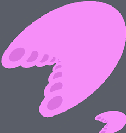
IKI-IKI Hoikuen
"IKI-IKI Phone is a multi-user, networked Artificial Life (=Alife) art game for the I-mode mobile phones. In this system, subscribed users can create Artificial Life creatures (=IKI-IKI pets), interact with these pets, feed them, take care of them, and evolve them. Networked users can also share their pets with other mobile phones users, trade them, watch them compete against each other, become friends with each other, create offspring and develop an IKI-IKI pet society. Users can also start communicating with each other through their shared pets."
A collaboration between Alan Dorin, Christa Sommerer, Laurent Mignonneau and the students of the Institute for Advanced Media Art & Sciences (IAMAS), Ogaki, Gifu, Japan. Read "IKI-IKI Phone: a Multi-user Alife Art Game for Mobile Phones."
Posted by jo at 06:30 PM | Comments (0)
August 20, 2004
murder
Those were the themes in an interactive, fictitious murder mystery and sightseeing tour developed by four graduates of the Canadia Film Centre's Habitat Lab, Toronto. The idea was to let participants tour the neighborhood while at the same time trying to solve the mystery. En route they visited the Gladstone and Drake Hotels, the Beaver Cafe and the DeLeon White Gallery, gathering clues and directions by dialing their cellphones, reading text messages, and examining physical evidence and computer displays at different sites.
The mystery/sightseeing tour was a prototype. It lasted only two days, but interesting developments were expected. Regrettably Ian Harvey, a journalist and one of the project's producers was the only person named in the Globe article.
Posted by newradio at 05:26 PM | Comments (2)
where are we eating?

Digesting Sound
where are we eating? is a translocal radio feast. Site-specific dining at ISEA 2004 and around the world. This is a project which aims to nourish. "We are interested in exploring hybrid transmission spaces dispersed and mobile modes of exchange, eating as a particpatory performance, cooking as a collaborative creation."
where are we eating? radio feast will be broadcast on 21-22 August 2004 on ÄÄNIRADIO 103.1 FM, online and on the streets of Helsinki where Grilli Radio will explore the local foodscape.
Posted by jo at 11:52 AM | Comments (1)
August 17, 2004
WiFi.ArtCache
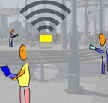
Local Networked Clouds
"The design challenge of this project is to create an apparatus that brings together physical proximity, narrative, interactivity and physical space in such a way as to engage a discourse about ubiquitous computing and the production of space."
WiFi.ArtCache reveals the leaky, spongy abutment joining our data and our physical world by tracing out the contours of networks. Through the limited range of WiFi systems, the Caches 802.11 radio creates a spatially constrained range of influence. Rather than relying on 802.11 WiFi technology to extend the reach of the Internet into physical space, WiFi.ArtCache uses 802.11 in a reverse mode of operation it relies on its limited range to create a small, local network cloud. See other Julian Bleecker projects at techkwondo
Posted by jo at 03:00 PM | Comments (0)
August 15, 2004
Umbrellas in the Net
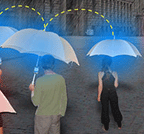
Spontaneous Wireless Mesh Networks
Gizmodo reports on Bluetooth Umbrella Networks: A team called "Umbrella.net" (no relation to Umbrella Corp, we hope) has developed a prototype system of Bluetooth umbrellas that facilitate "sudden, striking, and unexpected connections between people in public and urban space" by forming ad-hoc mesh networks when unfurled. As each umbrella is opened and added to the network, it lights as it comes online.
reblogged from Smart Mobs; posted by Paul Hartzog. August 13, 2004 at 09:46 AM
And Unstrung adds in Umbrellas in the Mesh:
In other words, create spontaneous wireless mesh networks that form when people put their umbrellas up -- and end when the rain stops.
This kind of mesh technology allows the devices themselves to act as nodes, passing data back and forth in an ad hoc setup, without a fixed connection to the wired Internet -- unlike the majority of commercial mesh products available.
The UMBRELLA.net project itself says:
UMBRELLA.net is a project exploring transitory or ad-hoc networks and their potential for causing sudden, striking, and unexpected connections between people in public and urban space. The project focuses on the theme of "coincidence of need", or how shared, yet disconnected activities can be harnessed into collective experiences. UMBRELLA.net examines how the haphazard and unpredictable patterns of weather and crowd formation can act as an impetus to examine coincidence of need networks. In particular, when umbrellas are opened and closed in public space. The project will attempt to highlight these informal relationships by creating a system of ad-hoc network nodes that can spontaneously form and dissipate based on weather conditions.
Now we finally know what those lighted umbrellas in Ridley Scott's film Blade Runner are.
Posted by jo at 01:05 PM | Comments (1)
August 08, 2004
Noderunner

Racing Against Time
Noderunner--by Yury Gitman, Carlos J. Gomez de Llarena--is "a competitive game (that) fuses the streets with wireless networks to convert the city into a playing board. Two teams racing against time must log into as many modes as they can and upload photographic proof to the server, documeting their progess." Noderunner won the Golden Nica for Net Vision/Net Excellence at Prix Ars 2003. Read more
Posted by jo at 04:02 PM | Comments (0)
August 05, 2004
Whitman's phones

Cellphone Performance
11 October 2002, Leeds, UK: (Evolution 2002: PROCESS) During his first visit to the UK, seminal American artist Robert Whitman produced a 30 minute cellphone performance based on a 1960's work he originally performed using payphones in New York City.
The performance in Leeds used 30 volunteers with cellphones stationed at pre-defined locations around the city centre. The volunteers repeatedly called a central telephone number and switch board situated in Millennium Square and, when their call was answered, gave a short description of their location. The resulting calls were mixed by Robert and relayed live through public address speakers to an audience in the outdoor square. The performance painted an aural description of the city at that given time.
During the 1960's Whitman distinguished himself with sophisticated theatrical works involving interaction between live performers and filmed images. For more information on this little-known artist, who along with with scientists Fred Waldhauer and Billy Klüver and artist Robert Rauschenberg, cofounded in 1966 Experiments in Art and Technology (E.A.T.), a loose-knit association that organized collaborations between artists and scientists, see Robert Whitman’s Telecommunication Projects by Bettina Funcke. As Funcke writes, "The little-known work of Robert Whitman...deserves serious reconsideration, partly because it can be seen as an unconscious prehistory to much of today’s art."
Posted by newradio at 08:29 PM | Comments (0)
Fun with Videophones

The Hookup
An original production by Kurt Bigenho, Harmon Leon, and Hal Phillips, The Hookup is a live, interactive reality spectacle using (or mis-using) the marvels of video phone technology. Two contestants will hop from bar to bar trying to score. The imagery will be sent back to the gallery via videophones and you, the audience, will decide what happens next! (more)
Posted by jo at 04:19 PM | Comments (0)
Spectropolis: Mobile Media, Art and the City
New Urban Experience
Spectropolis: Mobile Media, Art and the City is a three-day event that highlights the diverse ways artists, technical innovators and activists are using communication technologies to generate new urban experience and public voice. The event explores what is possible when wireless communications (both new and old), mobile devices and media converge in public space. The increasing presence of mobile communication technologies is transforming the ways we live, construct and move through our built environment. The participants of the Spectropolis exhibition make obvious or play with this shift, creating new urban perceptions and social interactions with cell phones, laptops, wireless internet, PDAs and radio. In addition to the projects presented in the park, there will be several hands-on workshops and two panels free to the public. Find out more
Posted by jo at 12:41 PM | Comments (0)
In the New Nation, I want _____
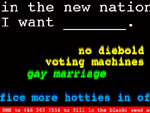
The Screensavers
At the NewNation Party in DUMBO Brooklyn, NY a few weeks ago, a collaborative group of NYC artists known as Screensavers produced a live SMS-interactive video projection. Their projection posed questions to the party guests as they lined up to enter the venue, such as "In the NewNation I want ____", or "I would ____ for _____ in the NewNation." At the bottom of the projected image was a call to fill in the blanks by sending a cell phone text message to a particular phone number. Submitted text messages would appear in the projection, and scroll as new messages were received. The projection lasted a few hours, and was located in front of the event in DUMBO where 100-200 people waited in line to enter the venue. There were approximately 2000 total attendees, and the projection steadily received an incoming stream of messages. (more)
Posted by newradio at 11:22 AM | Comments (0)
August 04, 2004
After the Crash

RICHAIR2030
RICHAIR2030 by TAKE2030 is a fictional wireless performance set in year 2030. RICHAIR2030 incorporates ideas of the freenetwork movement developed worldwide in the early 21st century and proposes shared public consumption of wireless bandwidth in an "After the Net", "After the Crash" scenario.
It is the year 2030. The great wireless hope that promises mobility and connectivity has bubbled. The GPS satellite signals have lost track of its urbanites when cutting through the Ozone layers. The ocean-apart digital divide has sabotaged the Net. What remains of the feeble bandwidth is held and safeguarded by the wireless freenetworkers, whose self-organized and decentralized network maintains its data cloud in local communal mesh-settings. The mobile generation is grounded. The tribal gathering around freenetwork nodes is the only game in town, bringing together the signal-seeking Desparati. The self-appointed renegade roller girls, acting as the Transmitenti of free bandwidth, travel city limits in auto-powered modules. Equipped with homemade lunchbox chiputers, the roller girls pump the remaining wireless signal strength in RGB codes and sonic extravaganzas. RICHAIR2030 mobilizes roaming nodes and calls for trans-national virtual mesh network.
RICHAIR2030 works with London freenetworkers and pays tribute to the world wide wireless freenetwork movement.
RICHAIR2030 team has developed 3 chiputer (compact computer with single chip motherboard) lunchboxes that draw parallels and refers to the techno DIY culture characteristic to the UK media scene at the turn of this century. The software system is based on free BSD, linux and mesh AP applications that allow automated reboots, wireless roaming, and data push at chosen locations. The interface programming further translates raw data into visual and sonic applications. In its compact lunchbox a 256 MB flashcard holds all the data.
RICHAIR2030 is developed by TAKE2030 brave new media society that sets up and manages multiple research+development+action media-working units. TAKE2030 designates its media practices in Commons societies and proposes its strategic programme development till year 2030. Take2030: Ilze Black, Alexie Blinov, Shu Lea Cheang, Chia-liang Kao, Paul Khera, Gio D'angelo in collaboration with East London community network and sonic artists: Supermoden and 1010.org.
RichAir2030 is currently touring the UK. Next performance: August 15, 2004, Bow Arts Festival, London
Posted by newradio at 12:16 PM | Comments (0)
August 03, 2004
Painting the Street
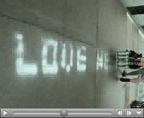
Bikes Against Bush
From "Bike Writer Pedals for Protests" by Leander Kahney, Wired News, August 2, 2004
New Yorker Joshua Kinberg is a bike messenger of a different stripe. Instead of ferrying legal papers between lawyers, he uses a homemade, wireless, bicycle-mounted dot-matrix printer to spray protest messages in the street...[Bikes Against Bush is] "painting on the street, but on the Net, too," said Kinberg, a post-graduate student at Parsons School of Design.
Continue reading at Wired.com
Posted by jo at 10:37 AM | Comments (1)
August 02, 2004
iSee Wireless

iSee Wireless
We are in the midst of two wireless revolutions, one defined by large corporations that buy spectrum, the other defined by ad hoc networks and open standards. We are focused on contributing to this second, more democratic revolution.
Julian Bleecker (Art Cache Machine, WiJacker, Proximity Wireless projects utilizing WiFi Toolkit software.) explores practical and playful uses of WiFi through a series of projects created with the WiFi Toolkit, a set of software APIs Bleecker developed as Engineer in Residence at Eyebeam. Art Cache Machine, the WiJacker and Proximity are three WiFi-enabled applications developed to investigate the possibilities of "partially connected" WiFi social networks using access points deliberately off the public internet. Art Cache Machine is a mobile WiFi node that provides an access point for specific digital art that can only exist within the locale of the Machine's WiFi node. WiJacker assumes the role of a WiFi node by hijacking the activity of users. Proximity is an ad-hoc communication service that enables connections between devices without user intervention.
iSee is a web-based application charting the locations of closed-circuit television (CCTV) surveillance cameras in urban environments. With iSee, users can find routes that avoid these cameras -
Who should use iSee
The past several years has seen a dramatic increase in CCTV surveillance of public space. Video cameras peer at us from the sides of buildings, from ATM machines, from traffic lights, capturing our every move for observation by police officers and private security guards that often act with very little public or legislative oversight. While the effectiveness of these devices in reducing crime is dubious at best (see below), recent cases of misuse by public and private authorities serve to question the appropriateness of video monitoring in public space. Here is a short list of people who might legitimately want to avoid having their picture taken by unseen observers:
Minorities
One of the big problems with video surveillance is the tendency of police officers and security guards to single out particular people to monitor. It is hardly surprising that the mentality leading to racial profiling in traffic stops has found similar expression in police officers focusing their cameras on people of color. Indeed, a recent study of video surveillance in the UK, the leading user of CCTV surveillance systems, says that "black people were between one-and-a-half and two-and-a-half times more likely to be surveilled than one would expect from their presence in the population." It is worth pointing out that, in this study, 40% of people that the police targeted were picked out "for no obvious reason," other than their ethnicity or apparent membership in various subcultural groups. In other words, they were singled out not for what they were doing, but simply based on how they looked.
Women
It appears that police monitors just can’t seem to keep it in their pants when it comes to video surveillance. In a Hull University study, 1 out of 10 women were targeted for “voyeuristic” reasons by male camera operators, and a Brooklyn police sergeant blew the whistle on several of her colleagues in 1998 for “taking pictures of civilian women in the area ... from breast shots to the backside."
Youth
Young men, particularly young black men, are routinely singled out by police operators for increased scrutiny. This is particularly true if they appear to belong to subcultural groups that authority figures find suspicious or threatening. Do you wear baggy pants or shave your head? Smile – you’re on candid camera!
"Outsiders"
The Hull University study also found a tendency of CCTV operators to focus on people whose appearance or activities marked them as being "out of place." This includes people loitering outside of shops, or homeless people panhandling. Not surprisingly, this group includes individuals observed to be expressing their opposition to the CCTV cameras.
Activists
Experience has shown that CCTV systems may be used to spy on activist groups engaged in legal forms of dissent or discussion. Indeed, the City College of New York was embarrassed several years ago by student activists who found, much to their dismay, that the administration had installed surveillance cameras in their meeting areas. This trend shows no signs of abating: one of the more popular demonstrations of CCTV capabilities that law enforcement officials and manufacturers like to cite is the ability to read the text of fliers that activists post on public lampposts.
Everyone else
Let’s face it – we all do things that are perfectly legal, but that we still may not want to share with the rest of the world. Kissing your lover on the street, interviewing for a new job without your current employer’s knowledge, visiting a psychiatrist – these are everyday activities that constitute our personal, private lives. While there is nothing wrong with any of them, there are perfectly good reasons why we may choose to keep them secret from coworkers, neighbors, or anyone else.
But what’s the harm?
Clearly, video surveillance of public space represents an invasion of personal privacy. But so what? Having one's picture taken from time to time seems a small price to pay for the security benefits such surveillance offers. It's not like anyone ever sees the tapes, and let's be honest
Unfortunately, this is not entirely accurate. The fact is, there is very little oversight of video surveillance systems, and the question of who owns the tapes
The fact is, many of the cameras monitoring public space are privately owned. Banks, office buildings, and department stores all routinely engage in continuous video monitoring of their facilities and of any adjacent public space. The recordings they make are privately owned, and may be stored, broadcast, or sold to other companies without permission, disclosure, or payment to the people involved.
Similarly, video footage that is captured by public police departments may be considered part of the "public record," and as such are available for the asking to individuals, companies, and government agencies. At present, there is precious little to prevent television programs like "Cops" and "America's Funniest Home Movies" from broadcasting surveillance video without ever securing permission from their subjects.
Sound far-fetched? Already in the UK
Similarly, there has been a proliferation of "spy cam" websites featuring clandestine footage of women in toilets, dressing rooms, and a variety of other locations. A lack of legislative oversight allows these sites to operate legally, but even if new laws are passed, the nature of the Internet makes prosecutions highly unlikely.
As video surveillance systems evolve and become more sophisticated, the opportunities for abuse are compounded. Sophisticated video systems can identify the faces of individuals (matching video images to databases of known faces
All of this says nothing about the societal impact of our increasing reliance on surveillance, and our growing willingness to put ourselves under the microscope of law enforcement and commercial interests. Once a cold-war caricature of Soviet-style communist regimes, the notion of the "surveillance society" is increasingly employed to describe modern urban life in such bastions of personal liberty and freedom as the United States, United Kingdom, and Canada.
While the nature of such a society has been long theorized by philosophers, critics, and sociologists, the psychological and social effects of living under constant surveillance are not yet well understood. However, the impacts that CCTV systems have on crime are beginning to be known.
Video Surveillance and Crime
Touted as a high-tech solution to social problems of crime and disorder by manufacturers selling expensive video surveillance systems to local governments and police departments, CCTV has gained much popularity in recent years. These manufactures claim that CCTV
CCTV is often promoted with thinly veiled references to the threat of terrorism: hence their widespread use in the UK, which has long lived with bomb threats and other violent actions. Already, in light of the September 11 attacks, video surveillance manufacturers have begun to court the American public
Attempting to capitalize on an international tragedy to sell product in this manner may seem tastelessly opportunistic at best. Given the track record of CCTV systems to date, this strategy seems downright cynical. According to studies of the effectiveness of video surveillance in use throughout the UK, there is no conclusive evidence that the presence of CCTV has any impact on local crime rates. While there have been examples of reduced criminality in areas where CCTV has been installed, these reductions may also be explained by other factors, including general decreases in crime throughout the UK. Indeed, in several areas where CCTV was installed, crime rates actually increased.
Given the widespread use of these systems, it is surprising how infrequently they lead to arrests. According to one report, a 22-month long surveillance of New York's Times Square led to only 10 arrests (those cameras have since been removed). Furthermore, the type of crime against which CCTV is most effective seems positively mundane when compared to its advocate's claims of stopping terrorism and kidnappings. A study of CCTV use in the UK found that the majority of arrests in which video surveillance played a significant role were to stop fistfights. Again, this was a relatively infrequent occurrence, and hardly seems to justify the price tag and loss of privacy these systems inherently engender.
More disturbing, however, was the finding that incidents of police brutality and harassment captured by CCTV surveillance were routinely ignored. The tapes of these events also had a tendency to be "lost" by operators.
The effect of video surveillance on criminal psychology is also not well understood. One Los Angeles study found that cameras in a retail store were perceived by criminals as a challenge, and in fact offered became an inducement towards shoplifting.
At best, CCTV seems to not reduce crime, but merely to divert it to other areas. According to one Boston police official, "criminals get used to the cameras and tend to move out of sight."
A final thought...
Given heightened awareness of public safety and increased demand for greater security in the face of growing threats of terrorist violence, projects that undermine systems for social control may seem to some viewers to be in poor taste. It is the Institute for Applied Autonomy's position that such times call out all the more strongly for precisely these kinds of projects. As spytech dealers stumble over themselves in their haste to auction off our civil liberties - wrapped in the stars and stripes, tied up tight with memorial ribbons - to right-wing politicos who drool and salivate in anticipation of railroading their own Orwellian wet-dreams of social control through our legislative bodies, there is a vital need for independent voices that cry out against such cynical exploitation of legitimate human fear and suffering for political power and monetary gain. The Institute for Applied Autonomy is such a voice. iSee is our statement.
- Brought to you by the Institute for Applied Autonomy "now more than ever"
Posted by michelle at 12:55 PM | Comments (0)
August 01, 2004
Mixed Reality in Los Angeles
GPS Walkabout
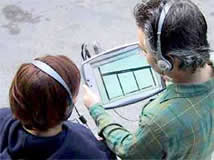 34 North 118 West plays through a Tablet PC with Global Positioning System receiver and headphones. GPS tracks your location to determine how the story unfolds - in real time, in real space, as you traverse the sidewalks of Los Angeles.
34 North 118 West plays through a Tablet PC with Global Positioning System receiver and headphones. GPS tracks your location to determine how the story unfolds - in real time, in real space, as you traverse the sidewalks of Los Angeles.
Description of Tour
Imagine walking through the city and triggering moments in time. Imagine wandering through a space inhabited with the sonic ghosts of another era. Like ether, the air around you pulses with spirits, voices, and sounds. Streets, buildings, and hidden fragments tell a story. The setting is the Freight Depot in downtown Los Angeles. At the turn of the century Railroads were synonymous with power, speed and modernization. Telegraphs and Railroads were our first cross-country infrastructures, preceding the Internet. From the history and myth of the Railroad to the present day, sounds and voices drift in and out as you walk.
Posted by michelle at 06:07 PM | Comments (0)
July 31, 2004
Mobile Culture-Scratching
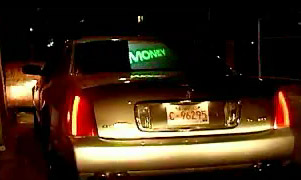
VJ-Fleet
by Julie Andreyev, at New Forms Festival 2003, consists of 3 cars fitted with video projection on the rear windshield. Each car has a theme determined by the character of the car, and by characteristics of the host city where the fleet is mobilized. The choice of cars for the project reflects the specific car culture of the host city expressed through customization and branding.
Mobile Equipment
The cars are set up with equipment to allow for mobile video downloading, and video mixing using data from the car. While the fleet is mobile, videographers in the downtown site are creating videos for projection on the cars. The themes are used as a guide for them to create footage of the activities of a city's inhabitants.
Networked Process
This footage is uploaded by the videographers onto a web server. Then, the footage is downloaded by the cars as they drive by WIFI (wireless internet) download sites. A sound artist records ambient sound using a microphone held outside the window of one of the cars, mixes this, and plays it back using an FM transmitter. Nearby cars can tune into our frequency and hear the audio sampling. Each car is equipped with a sensor and software patch that interprets data from the car.
Software Interface
For example, one sensor reads data from the engine speed. This data causes a kind of 'jittery' effect to be applied to the video. The faster the car revs, the more 'jittery' the video. In this way, not only are the inhabitants of the city portrayed, but also the car is expressed in the video. After the performance, the cars can be driven into a gallery space where they can be set up to project their archive of the evenings' videos.
Mobile Portrait of the City
The goal of this project is to create a mobile portrait of the city through video and audio sampling of real time events. VJ-Fleet relies on current VJ (or video jockey) culture and the hosting city's local car and social culture. For each performance the project is customized and scaled to reflect the particular nature of the host city.
Posted by michelle at 06:37 PM | Comments (0)
July 30, 2004
Distributed Cinema
SPEC-FLIC
Described by Adriene Jenick as a "Speculative Distributed Cinema Project....a series of fictional events performed as distributed cinema. SPEC-FLIC is a platform for speculation, creative experimentation and imagination among UCSD students, faculty, staff and the larger public. SPEC-FLIC's title refers to speculative fiction (an area of science fiction that is focused less on new science/tech and more on societal impacts) as well as to the size (a "speck") of the PDA-based video frame that serves as the conduit for this durational collective performance. Originally described as a distributed science fiction soap opera in three phases."
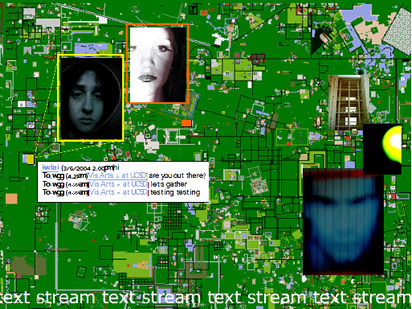
Adriene, tell us about this image.
What is the technology and experience behind this work?
Would you speak about the progression of your work from Paper Tiger television to Desktop Theatre on the internet to Active Campus and Spec Flic on the wireless network?
In your initial post you note these ongoing issues. Can you discuss them by way of examples from your work?
- timing/pacing/duration
this can be thought of from the perspective of participants or from "viewers" - in my experience the "lags" and glitches are all absorbable within the context of a live event. The archiving of this work does not allow for its tension to exist
- relationship of writing to performing, or textuality and orality
this is hugely fascinating to me especially considering the constant evolution of written and spoken language
- use of agitprop to catalyze unexpected engagements
all of my work is engaged within the larger "publc sphere" and cedes a large amount of control to the folks who are engaging with it.
Regarding SPEC-FLIC, your blog shows you in the midst of testing equipment. What are you testing? What is your creative process for working with technology and networks?
Posted by michelle at 09:42 PM | Comments (0)
July 27, 2004
More about Blast Theory
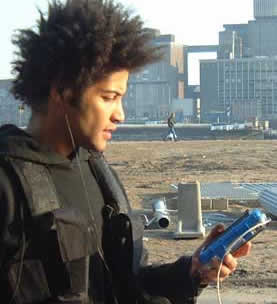 Matt Adams of Blast Theory posted a comment of encouragement to the blog's opening and I'd like to follow up with more about Blast Theory and a call out to Matt to respond to some specific questions about their work.
Matt Adams of Blast Theory posted a comment of encouragement to the blog's opening and I'd like to follow up with more about Blast Theory and a call out to Matt to respond to some specific questions about their work.
Blast Theory, comprised of Matt Adams, Ju Row Farr, and Nichols Tandavanitj, describe themselves as 'an artist group whose work explores interactivity and the relationship between real and virtual space with a particular focus on the social and political aspects of technology. It confronts a media saturated world in which popular culture rules, using video, computers, performance, installation, mobile and online technologies to ask questions about the ideologies present in the information that envelops us.'
This is evident in a survey of their work over the past decade. Formed in 1991, a chronology of their work from 1994-2004 is available on their website where the themes and explorations of technology range from video in live performance to interactive installations with the most recent using a pda or 3G phone to enable a mixed-reality game-based experience.
Beginning with their 1999 work Desert Rain and continuing on to the mixed reality works Can You see Me Now (project website), Uncle Roy All Around You (project website), and I Like Frank (project website) they have collaborated with the Mixed Reality Lab (MRL), an interdisciplinary research initiative at the University of Nottingham which brings together leading researchers in Computer Science, Engineering and Psychology to research new technologies that merge the physical and digital worlds, focusing on playful, artistic and educational applications.
The projects with MRL are clearly interactive in their game structures and use of mobile, networked technologies. The hybrid online/live action approach was explored in Kidnapped (1998) and interactivity has been a component in the early work since Stampede, (1994) in which the audience triggered how the piece unfolded via pressure pads.
Their work has been described as 'somewhere between theatre, performance art, installation and club culture' by Lois Keidan, Director of Live Arts, Institute of Contemporary Arts, London. In reviews of Uncle Roy in 2003 a direct link to the content and approach of their work can be found - a group of friends with various creative backgrounds get together to form a theater company. This comes through in Matt's initial comment to the blog in which he claims his excitement for recent developments in networked_performance, despite the backward looking stance of many traditionally moored theater and dance practitioners. Blast Theory is freed from any prior history in a single discipline by having a group comprised from various practices across which they draw to create their work.
Some Questions
Matt, firstly, correct any inaccuracies in the above. Would you tell us what are the backgrounds of the members and elaborate on the evolution of the group from the early years till now. What led to the formation of the group and why theater? It seems that BT has always had an interest in media and technology born of club culture perhaps. What is the importance of the 'live' and 'performance' aspects of your work? As opposed to addressing the same social and political themes about technolgical impact on culture by focusing solely on interactive installations, such as in An Explicit Volume, for example.
How did the collaboration with Steve Benford and MRL evolve? How has the relationship with MRL influenced BT's work conceptually? You might also elaborate on how the collaboration has enabled your work to evolve technologically as well. Can you speak about the offshoot of the BT / MLR collaborative endeavor, EVERPRESENCE and your project Vicinity to which you've been able to apply these joint efforts? It appears to include aspects of the mixed reality game-based works and a reality-tv episodic, perhaps. What's the timeline for presenting this work?
You also mentioned in your post that there is lots of interesting work happening in networked_performance. What's out there that you currently find interesting and why?...
Posted by michelle at 08:13 PM | Comments (3)
July 26, 2004
A PDA walkabout in Joyce's Dublin
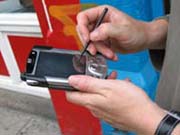
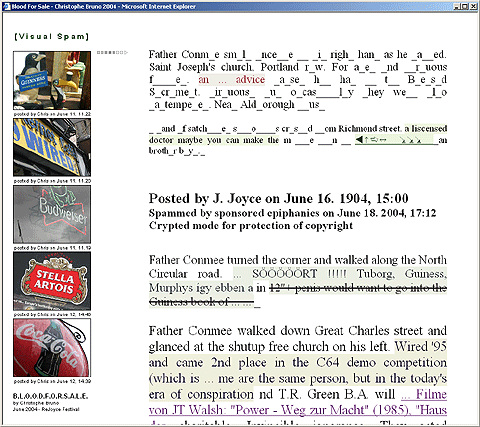
The program allows these "sponsored epiphanies" to disturb and transform the text of Ulysses, "Wandering Rocks", by incorporating themselves into the text. The real-time evolution of the text is displayed and graphically animated, sentence by sentence, projected in different places in Dublin, and online. By the end of the performance, carried out over several days, the original text by Joyce is almost entirely replaced by the "sponsored epiphanies".
Posted by michelle at 06:26 PM | Comments (0)

